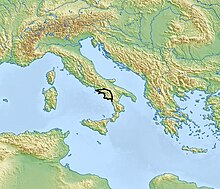This article includes a list of general references, but it lacks sufficient corresponding inline citations. (May 2014) |
 | |
| Horizon | Chalcolithic |
|---|---|
| Geographical range | South Italy |
| Period | 3150-2300 BC |
| Type site | Spina-Gaudo necropolis |
| Preceded by | Neolithic Italy |
| Followed by | Bell Beaker culture |

The Gaudo Culture is an Eneolithic culture from Southern Italy, primarily in the region of Campania, active at the end of the 4th millennium BC, whose typesite necropolis is located near Paestum, not far from the mouth of the river Sele.[1] Its name comes from the Spina-Gaudo necropolis.
Objects of this culture are known and have been recovered since Antiquity. During the 5th century BC and/or the 4th century BC, for example, Greek settlers deposited daggers made of flint probably from graves in an ancient sanctuary at the site of Paestum.[2] In the 18th century, objects were also recovered by scholars. For example, a flint dagger and a vase were brought from Italy to England by William Hamilton and are now in the British Museum.[3]
- ^ Bailo ModestiI G., Salerno A. (Eds), 1998, Pontecagnano II, 5. La necropoli eneolitica, L'età del Rame in Campania nei villaggi dei morti, Annali dell'Istituto Orientale di Napoli, sezione di Archeologia e Storia Antica, quad. n. 11, Napoli
- ^ Aurigemma S., Spinazzola V., Maiuri A., 1986, I primi scavi di Paestum (1907-1939), Ente per le antichità e i monumenti della provincia di Salerno, Salerno
- ^ Barfield L. H., 1985, Sir William Hamilton’s Chalcolithic Collection, in Swaddling J., Papers of the Sixth British Museum Classical symposium 1983, p. 229-233